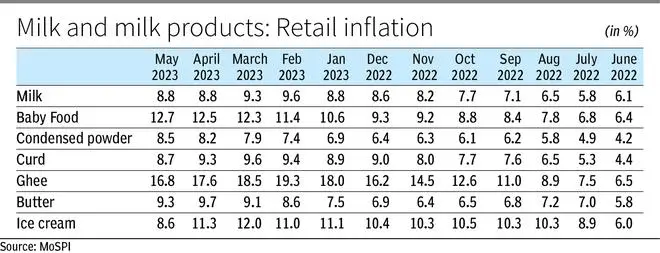Despite some moderation, retail inflation in milk is still more than double of headline inflation rate. Almost all the milk products are seeing very high inflation with ghee leading the pack.
Though industry insiders say that prices have started coming down and will soften further, they are still anxious about the impact of a late onset of monsoon.
Two key reasons for higher prices were costly fodder and costly fat. | Photo Credit: SRIRAM MA
Item-wise data, sourced from Statistics Ministry, showed that retail inflation for milk and milk products for May is in the range of 8.6 per cent to 16.84 per cent as against headline inflation of 4.25 per cent. While inflation for ice cream was lower in the pack at 8.60 per cent, ghee soared to 16.8 per cent. Barring baby food and condensed powder, all items recorded decline in prices but were still in the higher range.
Key reasons
Two key reasons for higher prices were costly fodder and fat. Also, previous flush season was not so good. However, industry insiders say the situation is changing. RS Sodhi, President of Indian Dairy Association and former MD of Amul, said: “Fat prices have gone up in last 12 months. But now prices have started softening. It is at the peak and will reduce further.”
The increase in fat prices started after August last year. “The current data (for May) are a result of base effect and the gap between year-ago level will narrow down from now,” Sodhi said.

Talking about ghee specifically, he said its prices have not increased in the last two months and in several places, the rates even declined by ₹20-30/kg during May. “You will see gradually, the prices will reduce. After August, it (inflation in ghee) will be half of this (May data),” he said.
Manish Bandlish, Managing Director of Mother Dairy, said the dairy industry is expected to maintain a healthy growth trend this fiscal with strong demand from both the consumer and institutional segments. “With improved supplies due to the extended flush season and replenishment of commodity stocks in the country, we foresee raw milk prices stabilising in short term,” he said.
Also read: Final Cost Inflation Index for FY24 to be fixed at 348
However, he emphasised, the progression of the monsoon along with the availability of feed and fodder will be the deciding factors for both raw milk and consumer prices going forward.
Earlier, there were indications that some milk products could be imported in limited quantity to cool down prices. However, Sodhi felt this phase is now over. There is surplus milk production now. Besides, global prices are at same levels as in India and this leaves little scope for import even at zero duty.
In April, the government was mulling to allow limited quantity import of dairy products such as butter and ghee, at zero duty for distribution through cooperatives. However, the plan was abandoned after opposition from some political parties and farmer groups.






Comments
Comments have to be in English, and in full sentences. They cannot be abusive or personal. Please abide by our community guidelines for posting your comments.
We have migrated to a new commenting platform. If you are already a registered user of TheHindu Businessline and logged in, you may continue to engage with our articles. If you do not have an account please register and login to post comments. Users can access their older comments by logging into their accounts on Vuukle.